Agree, everyone wants to have a reliable and durable roof over their heads. An important and very fundamental stage in the construction of a house is the erection of its structure and covering with the appropriate material. In addition to excellent performance, the roof must also have an excellent appearance. Let's find out the better to cover the roof of the house, what are the advantages of this or that coating.
Choosing a roof: selection criteria
The determination of the building material for the roof is a very important decision, which should be approached carefully and deliberately, because the roof is not wallpaper, you just cannot replace it. Technical parameters play a special role here.
So what is the best roof cover? First of all, we will reveal general characteristicsthat any roofing material:
- The coating must be resistant to UV rays.
- Tolerate critical temperatures: high - on hot days, extremely low - in winter frosts. Also, do not respond to sudden changes.
- Absolute tightness. The roof must never leak.
- High strength.
- Long service life of the coating.
- Immunity to the influence of external factors: mechanical stress, pollution, humidity, weather.
- Fire resistance. Of course, we all exclude the occurrence of force majeure situations, but it is better to be calm and confident in the quality of the roof.
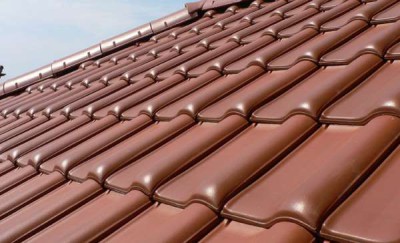
What is the best way to cover the roof of the house so that the result will please you with its appearance, what properties must be taken into account during the installation process? From this point of view, the selection criteria can be the following characteristics:
- Material color and shape.
- Roof weight. This factor is extremely important, since rafter system must withstand the weight of the coating.
- When choosing, consider the angle of inclination of the roof.
- Consider the complexity of the installation work, and possible repair coverage in the future.
- Material price. The budget must include the costs of installing the roof, if the work will be performed by specialists.
- The appearance of the roof should correspond to your taste preferences, and the technical side - to the requirements.
Basic classification
In the process of deciding what is the best to cover the roof of a house, a detailed classification of coatings according to various criteria will come in handy.
By the method of installation, the following types of roofing are distinguished:
- Rolled. Such material is referred to as economy class coverage.
Important! Ideal for roofs with slopes ranging from 0-30 degrees. An example of a roll coating is roofing felt.
- Sheet. It is convenient and quick to cover a large roof area with such material. This type includes: slate, metal, corrugated board.
- Mastic. It is a separate type of polymer coating.
- Piece. The cover structure consists of a large number of individual elements. This type of roofing material is distinguished by its presentable appearance and excellent quality. A striking example is all kinds of tiles.
In addition, roofing material is classified as follows:
- By the look of the base. Their variety is great, it can be metal, fiberglass, cardboard, asbestos cement.
- By the type of protective layer. Allocate a polymer version of the coating, metallized, mineral and others.
- According to the texture of the material - coarse or fine-grained roof, scaly, dusty.
- Depending on the type of binder, there are polymer and bituminous roofing materials, as well as an option that combines both substances.
Ondulin or Euroslate
Let's start with a fairly well-known material called ondulin. It is based on pressed cardboard impregnated with bitumen, which indicates the environmental friendliness of the product.
Important! This type of coating will last up to 50 years.
Advantages:
- Moisture resistance.
- Does not fade under the influence of ultraviolet radiation.
- Affordable price.
- Low weight.
- Easy and quick installation due to material flexibility and excellent plasticity.
- Ondulin is not subject to corrosion, as well as the appearance and spread of fungus, mold, and is not afraid of pests.
- Various colors and shades of material.
- Excellent sound and heat insulation properties of this roof.
Minuses:
- Fire hazard. At temperatures above 230 degrees, the coating ignites.
- Does not withstand sudden and strong temperature changes. In addition, under conditions of direct hot rays, ondulin becomes fusible, and in severe frost it becomes fragile.
- Low strength. Over time, the surface cracks, like any bitumen coating.
- Noise. During rain, and even with hail, the rumble will be heard in the house.
Important! Not suitable for steeply sloped roofs.
Traditional slate
This material is familiar to everyone. The gray wavy sheets of slate have probably been seen by everyone. And if the question is, the better to cover the roof, then this option cannot be ignored.
Important! The service life of slate is no more than 40 years.
Large sheets of this material have a wavy surface. Slate is produced from asbestos-cement mortar.
Advantages:
- Fire safety. The material itself does not burn, but it cracks during a fire.
- Long service life.
- Not susceptible to mechanical stress.
- Strong and durable. The slate is able to withstand the weight of an adult, as well as the accumulated layers of snow over the winter.
- The roof is not afraid of temperature drops.
- Moisture resistant.
- No noise from the rain is heard in the house.
- Easy installation. The main thing is that the process is carried out accurately. In addition to simple installation, the slate coating is subject to local repair if necessary. It is easier to replace one sheet than the entire roof surface.
- Modern slate can be painted in any color. Thanks to this, its appearance is improved, and the durability of the material is increased.
- Low price.
Minuses:
- Increased fragility. Sheets may split during transportation or handling.
- After a period of time, the edges begin to crumble.
- Sheets that are located in the shaded part of the roof can be covered with moss or lichen.
Important! Inspect and assess the condition of the sheets carefully before purchasing. There should be no dents or cracks on their surface. The slate edge should not have delamination, but should be perfectly flat.
Shingles
It is also a fairly popular building material for roofing. It is important to know that there are several types of shingles. What material is best to cover the roof of the house, based on the type of material?
Flexible roofing or bituminous shingles
Such a roof meets everyone technical requirements, has ample opportunities in terms of the choice of shades and forms of coating. Exactly soft tile allows you to create incredible and sometimes fabulous roofs of houses.
Such a coating is made in the form of plates of various shapes from fiberglass coated with bitumen, on top of which a decorative layer of mineral chips, stone dusting or basalt granulate is applied.
Pros:
- Simple and convenient installation. You can lay such a roof yourself, which will allow you to save tangible funds.
- Excellent sound insulation, which will save you from the rain knocking on the roof.
- Moisture resistance.
- Shingles are not afraid of solar ultraviolet radiation.
- Withstands a fairly tangible load.
- High degree of wear resistance.
- Environmental friendliness and hygiene of the material. Mold and moss do not form on the tiles.
- Thermal insulation.
Important! It is very effective to install bituminous shingles on the roof, under which the living room is immediately located.
- Low weight of elements, admissible coating weight in general.
- Durability of the soft roof. It will serve you for at least 20 years.
- Impact resistance Neither hail, stones, nor heavy branches can damage the coating.
Minuses:
- This shingle is not used on roofs with a slope of less than 12 degrees.
- A palpable price.
- Permanent care. A rough roof requires regular cleaning of leaves, branches and other debris from the roof.

Natural roof tiles
The better to cover the roof, if not natural and time-tested material. This type of roof has been used for a long time, and modern technologies only improved its performance.
Important! The basis of the ceramic coating is clay, so the material is environmentally friendly and safe.
Advantages:
- The main and indicative property of such a roof is its non-competitive durability - 50-100 years.
- A ceramic roof is not afraid of many external influences of the environment: humidity, low and high temperatures, ultraviolet.
- Wear resistance.
- Possibility of local repair.
- Presentable appearance, such a roof looks incredibly stylish.
Important! Nowadays, a natural tile roof is a very prestigious roof.
- Sound and heat insulation.
- Lack of electrical conductivity.
- Fireproof material.
Minuses:
- High price. Therefore, this material is used to equip the roofs of expensive cottages and houses.
- Time consuming installation. Shingles are a piece roofing, and unlike roll or sheet types, they take more time to install.
- Large mass. The perceptible weight of the tiles imposes corresponding requirements for load-bearing structures roofs.
- Brittleness under the influence of significant mechanical stress.
Important! Another type of natural tile is the material on cement-sand base... The properties of this coating are very similar to ceramics, but due to the fragility during delivery, as well as burnout in the sun, the price of such a roof is much lower.
Metal tile
Asking the hard choice of how best to cover the roof of the house, pay attention to this option.
Important! Metal tiles are made of galvanized steel, which must be covered with an anti-corrosion agent.
Manufacturers make sheets to look like shingles.
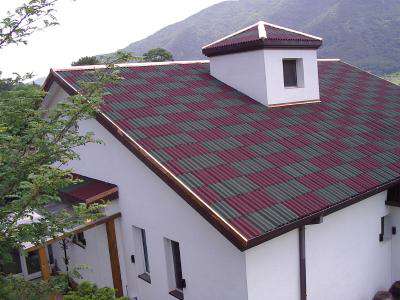
Pros of coverage:
- Installation of sheet material is simple and convenient.
- Moisture resistance.
- Decent service life of about 50 years.
- Not afraid of sunlight, does not fade.
- Low weight, which does not require additional strengthening of the supporting structures.
- External aesthetics. From a distance, the roof of your house will look like natural tiles.
- Affordable cost.
- A wide range of colors.
- Increased resistance to mechanical and weather influences.
Minuses
The disadvantages of such a roof are due, first of all, to the material itself, that is. metal. Therefore, they are as follows:
- Perceptible noise level. You will clearly hear the sound of rain on such a roof.
- Metals conduct heat easily, so thermal insulation is required.
- Damage to the coating may result in corrosion.
- Noticeable material consumption during installation.
- Not suitable for houses with flat roofs or small slopes.
Corrugated board
In the process of choosing which material is best to cover the roof of the house, many stop at this method. To some extent, profiled sheeting is comparable to metal tiles. They are united by:
- The base is galvanized steel.
- Same mounting technology.
- terms of Use
Important! The difference between corrugated board lies in wider sheets, as well as in a variety of profiles: U-shaped, trapezoidal, rounded.
Pros:
- Simple installation.
- Light weight.
- Strength and wear resistance.
- Low cost.
- Assortment of colors.
- Nice appearance.
The disadvantages include:
- Sailability. What does it mean? A strong wind or a hurricane can rip the corrugated board off the roof.
- Additional steam and thermal insulation will be required.
- As in the case of metal roofing, excellent sound conductivity and noticeable noise during rain.
- Control over damage to the surface of the sheets, since even minor scratches will lead to corrosion of the material.
Mastic or self-leveling roof
A modern way of finishing roofing is a self-leveling roof. The essence of the technology is as follows:
- On concrete or wooden base a polymer film is applied.
- After hardening, a solid coating with a monolithic structure is formed.
pros
The positive aspects of such roofing material are:
- Coating solidity. In this case, there are no joints and seams on the roof surface, which directly increases its tightness.
- Ability to withstand temperature extremes ranging from -40 to +100 degrees Celsius.
- Resistant to ultraviolet radiation.
- Low coating weight.
- Durability. The service life will be at least 15 years, and a high-quality coating with proper operation
- Does not rot or corrode.
Disadvantages:
- High price.
- Not applicable to roofs with a slope greater than 25 degrees.
- Installation is best done using the services of specialists.
Knowing about the types of roofing materials, their pros and cons, it will be easier for you to decide what is the best to cover the roof of the house. A wide choice allows you to implement any design ideas for the design of the roof, the main thing is that it is of high quality and long service life.
February 1, 2017
How can you cover the roof of a house inexpensively?
During the Soviet era, there were no difficulties when choosing roofing materials. In all hardware stores, only slate and roofing material could be purchased. Today the situation has changed, and a potential client is offered a lot of options. The solution to the question of how to properly cover the roof directly depends on the choice of roofing material.
Basic types: slate, metal profiles, metal tiles, ondulin. There are also more exotic species (tiles, keramoplast), but we need to figure out how to cover the roof of the house inexpensively and with the highest quality.
This roofing material has been used for decades. For such a long service life, all the positive and negative aspects have been identified.
disadvantages
Its main disadvantages include the following qualities:
- toxicity;
- fragility;
- moss may appear on the slate in shaded areas.
Benefits

Nevertheless, this roofing material is still sold in many home improvement stores. This means that there are positive qualities that are in demand by the consumer:
- affordable price;
- resistance to high temperatures;
- ease of installation;
- flat sheets of slate can be used not only for roofing, but also for the construction of some garden and outbuildings.
Sometimes sales consultants claim a “special” material strength. Whoever in childhood climbed onto the roof of a house covered with slate, will react to such a statement with a smile. Upon closer examination, it turns out that, all other things being equal, the material compares favorably with its counterparts only in price. For a residential private house, aesthetics is an important factor, and slate cannot boast of this. Therefore, this roofing material is a good option for small country house or outbuildings. It is better to refrain from covering a private house.
Metal tile
One of the most common roofing materials. Metal roofing is a material based on metals protected by polymer coating, has an aesthetic appearance.
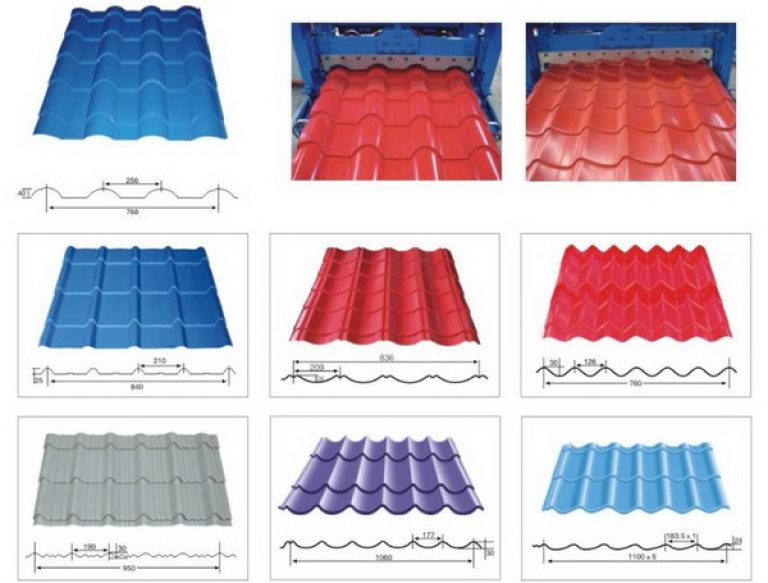
Benefits
The use of metal shingles is quite understandable by its positive characteristics:
- attractive appearance;
- wide color palette;
- working with metal tiles does not require special skills;
- durability;
Many manufacturers and specialized organizations cite the low cost of the material as an additional advantage. But for some reason they completely do not take into account that the accompanying and consumables also cost money. One of the main drawbacks is the predisposition of the material to condensation; to neutralize it, you have to purchase a special membrane, which also costs money.
disadvantages
Other disadvantages include:
- low sound insulation;
- during work, a large amount of surplus remains (about 30%);
- on metal tiles covered with a small layer of polymer materials, corrosion may appear.

In principle, the negative aspects cannot be said to be critical. Therefore, when deciding how to cover the roof, and most importantly, with what, metal tiles should not be discounted. This is one of the most common options. The price is a little confusing, but in general it is quite a worthy option.
Ondulin
The name of this roofing material, which is called "by ear", but what it is, without preparation, hardly anyone will tell. Ondulin is a soft roofing material developed in France. In appearance, it is similar to slate, and for its manufacture were used: bitumen, cellulose fibers, mineral fillers and special resins. Onduline cloth is impregnated twice during the production process bituminous compositions, and at the final stage it is covered with acrylic paints. 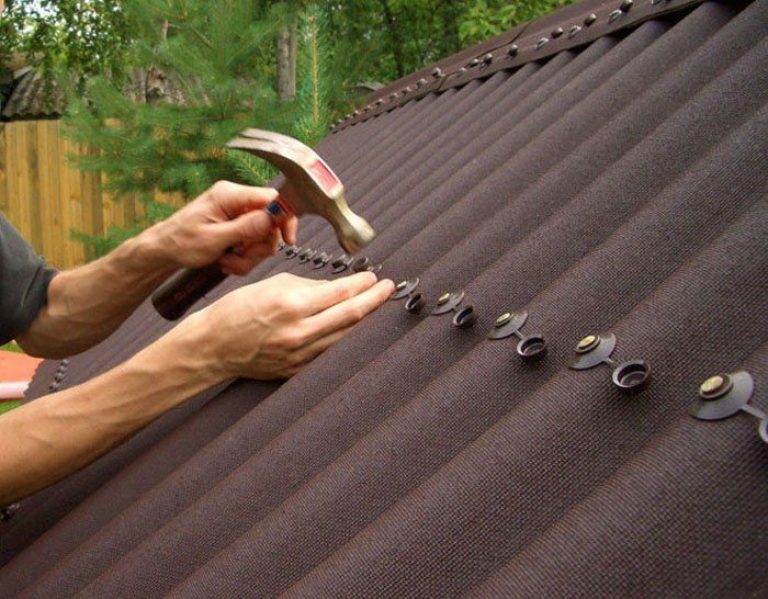
Benefits
The following circumstances speak in favor of choosing such a roofing material:
- light weight, which facilitates transportation and installation;
- ondulin is resistant to chemically active substances, sunlight, temperature extremes.
- the roofing material does not harm the environment and human health.
- mold and fungal diseases do not appear on ondulin.
Hardware stores and firms seem to be talking about "affordability" as advertising. A very controversial statement. Ondulin price tags start at 300 rubles excluding accompanying accessories.
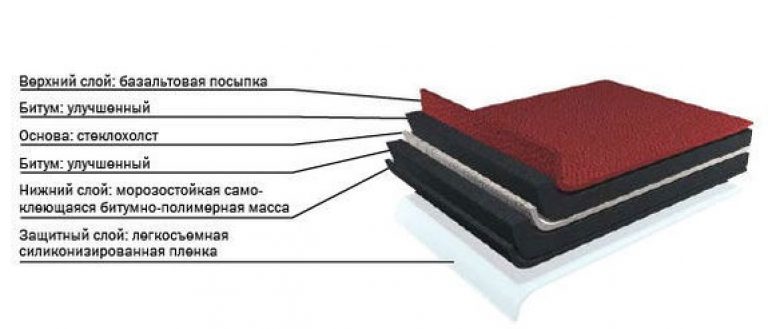
disadvantages
On the negative side, ondulin is characterized by:
- the material is susceptible to mechanical stress; after the completion of roofing work, it is better not to climb onto the roof;
- the joints between the canvases require special attention.
- some types of ondulin burn out with prolonged exposure to sunlight (partial solution to use a brown or red material).
For use anywhere in France or in Sochi - a decent enough roofing material. In harsher climates, where snow is sometimes transported in tons, the inability to withstand significant loads is suggestive.
Another controversial point is the flammability of the material. Of course, any owner will say that his stove / boiler / chimney is installed taking into account all fire safety requirements. But no one will give the same guarantee about nearby houses. Therefore, thinking about the best way to cover the roof, it is necessary to consider ondulin as a roofing material for a private one with caution and taking into account the climatic conditions of the region.
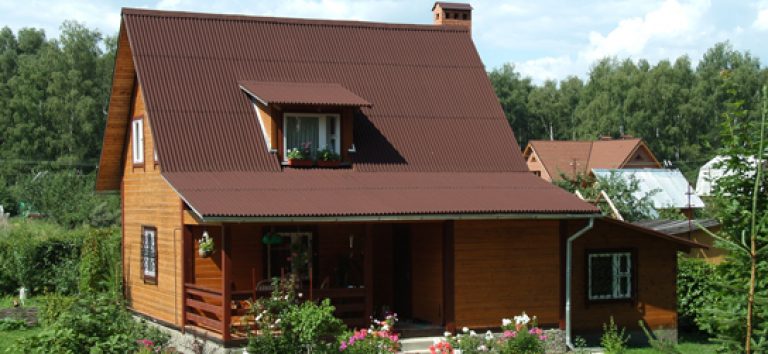
Metal profile (professional flooring)
The metal profile is produced not only for roofing works, there are also options such as wall (analogue of siding) and bearing (fences, outbuildings). Roofing sheeting has a higher corrugation, which increases its strength.
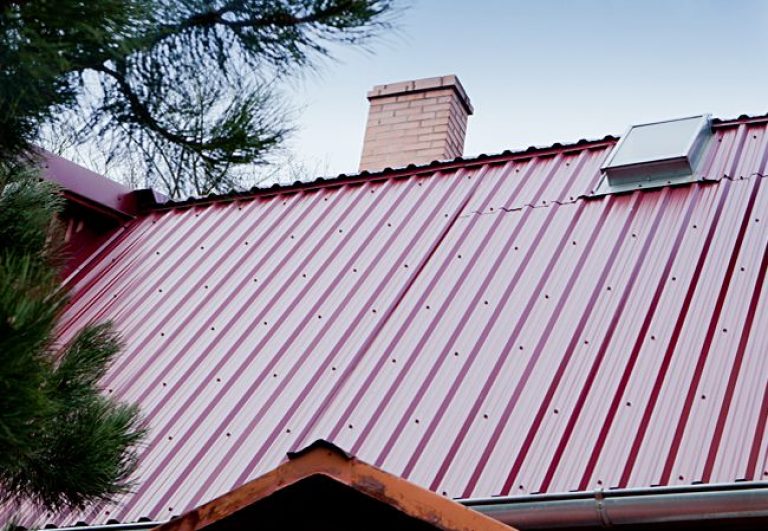
In addition, some manufacturers are experimenting with rolling mill rollers to achieve a great looking finish. In some cases, the corrugated board is not inferior to the design and metal tile.
Benefits
The metal profile occupies one of the top lines in the rating of roofing materials due to its positive qualities:
- resistance to precipitation and climatic conditions;
- long service life;
- resistance to abrupt temperature changes;
- does not respond to direct exposure to sunlight;
- safe for the health of the inhabitants of the house;
- a wide range of paints.
Pricing policy is, apparently, the disease of all salespeople and managers. For any question, the standard is heard: profitable, affordable, discounts up to 70%. It seems that the outlet is operating at a loss. In fact, not a single entrepreneur has ever been seen to be altruistic. However, this applies to all building and not only materials.

disadvantages
In addition to the price, the metal profile has other drawbacks:
- sound insulation is poor;
- condensation is possible (solved by a membrane);
- products of some companies burn out in the sun.
There are drawbacks, but the performance is not greatly affected. The material is equally in demand by the owners of private houses, solid country cottages and small summer cottages... The remains of the corrugated board can be used in the construction of outbuildings.
Summarizing
When analyzing technical characteristics materials used for roofing, it turns out that almost all of them have an attractive appearance (with the exception of slate), they serve long time, do not require special skills during installation, you can choose any color scheme. Therefore, in order for the roof to stand for a long time, you need to choose the material for it carefully, considering all the pros and cons.
The main parameter influencing the initial choice is. From this point of view, slate wins over all the listed roofing materials, but this is its only advantage.
Metal profiles and metal tiles are in approximately the same price range. However, corrugated board surpasses its counterpart in terms of practicality. Working with a metal profile, it is easier to calculate required amount material. It is believed that corrugated board can withstand more severe loads than metal tiles. Their negative qualities almost completely coincide.
In comparison with ondulin, the metal profile can be purchased at a better price. Profiled sheeting is more reliable than ondulin in terms of fire safety, and is more resistant to mechanical damage. In defense of ondulin, it can be said that, unlike corrugated board and metal tiles, it has a much lower mass and is considered more aesthetic.
Of course, a lot of roof coverings are offered today, and the final choice lies entirely with the owner of the house or summer cottage. But when considering this or that option, evaluate the material for the roof from the following sides: resistance to stress and damage, service life, design and price. The metal profile, by the way, fully meets these requirements, and the roof covered with it will stand for more than a dozen years.
Home is our fortress. The comfort and microclimate in all rooms depends on how correctly its roof is covered. In view of this, it is very important to take a serious and responsible approach to the choice of building material. He is an important basis for determining the life of the roof and its quality characteristics.
The range of coatings for roofing work is the widest. What is the best way to cover the roof of a house? What technical features of the material should you pay attention to? How to do everything correctly necessary work? More about this in the article.
Cover the roof frame house you can use tiles, ondulin, profile iron or ordinary slate. The listed roofing materials are practical to use, durable, easy and quick to install, and have a long service life.

Roof tiles are a coating with a special structure that ensures perfect roof tightness. It does not require painting, is resistant to mechanical, chemical and atmospheric influences, is characterized by excellent corrosion resistance, reliability and manufacturability.
The main advantages of shingles:
- Excellent decorative properties. The material has a presentable appearance, does not require additional processing, allows you to visually highlight the house and give it a special flavor.
- Heat resistance. The coating does not change its properties under the influence of ultraviolet radiation, does not fade, does not emit toxic substances hazardous to human health and the environment.
- Long service life. On average, a properly laid roof covering performs its functions flawlessly for 25 - 30 years.
- No need for regular repair work... The shingles do not require special care, withstand mechanical loads, do not deform and do not change their shape.
- Ease of installation. If you wish, you can cover the roof of a frame house yourself.
- High quality. The innovative technologies underlying the production of tiles guarantee their aesthetics and perfect match of the profile.
- Wide range of colors. Choosing the material of the desired color and type will not be difficult.
- Low windage. Even a strong gust of wind will not be able to disrupt or wrap up individual elements of the roof.
- The possibility of dismantling. If necessary, the tiles can be easily disassembled and reassembled, while the coating will not lose its basic quality indicators.
- Low weight. The material does not create additional load on the roof.
Disadvantages of shingles:
- Up to 40% waste in case of non-compliance with the accepted installation rules.
- Formation of condensation on the inner surface as a result of a sharp change in ambient temperature.
- In case of improper installation, short service life.
There are several types of material in question. For covering the roof of a frame house, bituminous, polymer sand, metal, cement-sand and ceramic tiles are perfect.
It is recommended to take the roof slope into account when choosing the residual coverage.
Watch a video about the installation of metal tiles:
Ondulin is another popular roofing material often used by builders. It consists of corrugated textile sheets covered with several layers of bituminous mixture.

Ondulin advantages:
- Rigidity and light weight. The material does not create additional load on the structure and allows you to make the lathing with a large step.
- Excellent noise and heat insulation. Ondulin does not allow extraneous sounds and can reduce heating costs by up to 30%.
- Resistant to corrosion, decay and rust. The coating perfectly withstands chemical and atmospheric influences, while maintaining its quality characteristics.
- Environmental friendliness. In the production of ondulin, materials and compositions are used that do not contain concentrations of toxic substances hazardous to human health.
Disadvantages of coverage:
- Low fire safety. Ondulin is flammable, so the risk of fire increases.
- Insignificant colors.
- Unstable decorative properties. Roofing material fades quickly when exposed to sunlight.
- Numerous joints.
It is cheaper to cover the roof with Ondulin than with tiles, but it should be noted that the material is not resistant to mechanical stress. Even a minor mistake made during installation works, can lead to roof leaks.

Profile iron - roofing material obtained as a result of deformation of sheet metal in a cold state on special roll forming equipment.
Its advantages:
- high performance characteristics. The corrugated board is resistant to mechanical, chemical and atmospheric influences. It does not change its properties under the influence of ultraviolet radiation, does not fade in the sun due to a special polymer coating.
- Speed \u200b\u200band ease of installation. The material is easily matched to the size of the roof slope, eliminating the need for vertical overlaps.
- Excellent waterproofing properties... If the roofing work is done correctly, the roof of the house will not leak.
- Low weight. This feature of the profile iron allows you to significantly save on the crate.
- Affordable cost. In conditions of a limited budget, the roofing device is best performed using this particular material.
Disadvantages of profile iron:
- Low rates of heat and sound insulation.
- Not the most presentable appearance.
- Rectilinear forms, little associated with residential buildings.
Profile iron will not be able to adequately impart respectability to the structure, make it warm, cozy and as comfortable as possible for living, despite the fact that its service life reaches 15 - 20 years, and the installation is carried out without any special technical delights.

Slate is another option for roofing material that can be used to cover the roof frame structure... It is made from asbestos cement, characterized by practicality, durability and ease of installation.
The main advantages of slate include the following features:
- Non-combustible and low thermal conductivity.
- Resistant to corrosion by water and condensation.
- Excellent sound insulation and high frost resistance.
- Durability and strength.
Disadvantages of roofing material:
- Content of asbestos hazardous to human health and the environment.
- Great weight. Average mass one leaf reaches 20 - 26 kg.
- Brittleness and instability to mechanical stress.
- The tendency to form moss on the surface, impairing the quality and functional characteristics.
A roof covered with slate is easy to repair: if necessary, one or more sheets of building material can be replaced without resorting to complex dismantling work.
But slate is not endowed with special aesthetic properties, therefore, if the decorative component is important to you, it is better not to consider the coating as a possible alternative.
Tiling technology
To properly cover the roof of a house with tiles, you must adhere to a technology that includes the following steps:
- First stage: laying the waterproofing. This process is carried out in a standard way: a selected waterproofing material is mounted on a previously prepared surface.
- Second stage: lathing device. The lathing is considered the basis for the installation of tiles. It is installed over the waterproofing. Sheathing bars - a perforated profile or wood treated with an antiseptic composition - are fixed to the roof frame.
- Stage four: skate assembly. Construction elements are fastened with self-tapping screws.
Stage three: installation of tiles. Construction material fits from the topmost point of the roof downward. Each slope must be covered separately.
First of all, the top row of sheets is laid. They are fixed using galvanized screws. Mandatory requirement: overlapping tiles. The next row of sheets is mounted in the same way.
Undoubtedly, the tiles can be laid on their own, but it is advisable to entrust the work to professionals, since any mistake made during the installation can cause the roof to leak.
A phased plan for working with a profile iron
All work on the roofing with profile iron is performed in several stages:
- Second stage: installation of the battens. The step of its installation depends on the height of the profile. For a 35mm sheet, it is 1.5 meters. It is recommended to lay profile iron less than 20 mm on a continuous crate.
- The third stage: laying the profile iron. The material is fastened down with each wave with self-tapping screws so that the capillary groove overlaps the next sheet. The transverse overlap is determined depending on the slope angle of the slope and is 150 - 200 mm.
- The fourth stage: the design of the skates, abutments to the walls and cornices with special elements that are attached with self-tapping screws.
First stage: device roofing cake - installation of steam and waterproofing. Steam and waterproofing materials fit in one direction, the effectiveness of their use largely depends on this.
The joints of the panels are connected with a special adhesive tape and securely fixed to the base of the roof of the house. The ventilated gap between the waterproofing and the profile iron should be 20 mm.
Roofing it is not recommended to use profile iron in rainy and windy weather for safety reasons.
Review of the cost of materials for roofing work
Shingles are considered one of the most popular roofing materials. Its price largely depends on the quality characteristics and on average varies from 300 to 500 rubles. per sq. m.
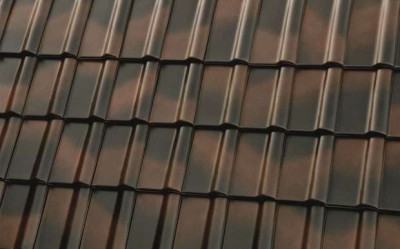
Among the numerous coating brands, the leading positions in the market are held by Roben, Finnera, Monterrey, Decorrey, Dune, Prestige, IKO, Ruflex. The products of these brands are of excellent quality and comply with European standards. Services for laying tiles will cost from 250 to 700 rubles. per sq. m.
The cost of ondulin ranges from 300 to 650 rubles. per sheet. Among the popular grades of the material, the ONDULINE brand should be separately noted. The entire range of products of this brand has excellent quality characteristics and in all respects meets the current standards.
Professionals are ready to perform ondulin installation in the following price range: from 150 to 500 rubles. per sq. m.
A sheet of roofing profile iron is sold at a price of 330 - 370 rubles. The final price of the material depends largely on the technical features, brand and parameters.

Popular manufacturers of high-quality profile iron: Gerard, Profit, Lion Steel. The average cost of roofing work for laying corrugated board: simple roofing - 460 rubles. per sq. m, average roof - 550 rubles. per sq.m., complex roof - 610 rubles. per sq. m.
The cost of a sheet of asbestos slate is 210 - 290 rubles. Professional masters are ready to perform roofing works in the price range from 45 to 230 rubles. per sq. m.
Summing up, we can conclude that it is cheapest to finish the roof with slate. Laying the tiles will cost several times more, but if the budget allows, it is better to choose this particular roofing as the best option, it does an excellent job with its main functions and allows you to create optimal comfortable living conditions in the room.
Watch a video selection on the choice of roofing materials:
Was this article helpful?
House roof design
When building or renovating a summer house or cottage, many ask a reasonable question: how to cover the roof of the house? The choice remains only with the owner of buildings and structures. However, today the characteristics have been determined, according to which it is recommended to choose a material for the roof.
There are many roofing options on the market, each of which gives homes a charming look. It is worth noting that the choice is very often influenced by fashion trends, but the material must always be of high quality.
Classification of roof coatings according to various criteria
Conventionally, all roofing materials can be divided according to various reasons:
Before thinking "how to cover the roof", you need to choose a roof structure, because the type and volume of material and the cost and complexity of the work will depend on this.
- according to external characteristics, there is a roll, sheet or piece roof;
- there are organic or mineral materials for the feedstock;
- depending on the type of top coating, there is a roof with a metallized or polymer film;
- according to the binder option, the material for the roof is divided into polymer, bituminous and bitumen-polymer;
- by the type of the protective layer, the roof is scaly, coarse-grained, dust-like and fine-grained;
- finally, by the type of base, there is a roofing on cardboard, fiberglass, foil, fiberglass and steel.
From all this variety, you need to choose for yourself which roof is better. Therefore, first you need to decide what qualities it should have.
Important requirements for the roof
All roofing materials comply with certain norms, which are spelled out in special documents (technical conditions and state standards). Any materials that do not meet the required standards are not allowed on the market and cannot be used in construction.
So what should be your roof covering?
- Resistant to sun UV rays;
- Resistant to temperature extremes (both frost-resistant and not susceptible to heat, the coating should thaw easily and not deform when frozen);
- Airtight (the roof should not allow moisture to pass through, i.e. leak);
- Resistant to external influences (weather conditions, dust, dirt, harmful gases);
- Durable;
- Long lasting.
Properties of roofing materials
Before using and buying a roofing covering, you need to know its properties, as well as the conditions for working with it and its installation. This is the only way to achieve long-term and rational operation of the roof.
The strength, density of a coating is the technological properties of the material. They are very important and you should definitely pay attention to them when choosing the best way to cover the roof of the house. These properties include frost resistance. For the northern regions, it should be higher, because such a roof will be subjected to freezing constantly (every winter).
If your roof is going to be exposed to strong heat, then the roof must have such a property as fire resistance.
Each version of the roofing material undergoes laboratory tests, where its following properties are determined:
- Technological,
- Mechanical,
- Chemical,
- Physical.
Knowing what properties the material should have for your roofing, you can determine how best to cover the roof of the house. However, you should first study all the properties of specific roofing materials.
Bet on simple installation - slate sheets
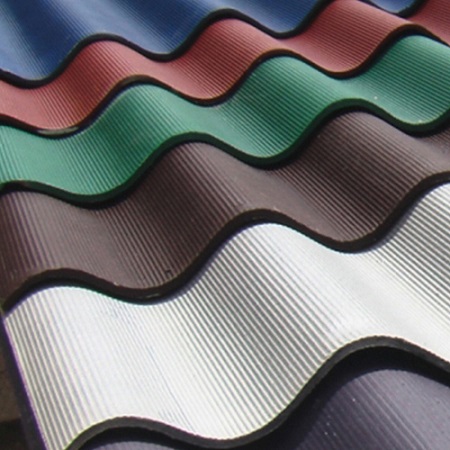
Slate is a large wavy sheet. It is made exclusively from asbestos-cement mortar. Such material is durable. However, its main disadvantage is excessive fragility.
The standard size of each sheet is 1750mm in length. The width of the sheet can vary between 980-1130mm. Every 150 / 200mm, waves rise up to 54mm on the slate surface.
Slate perfectly tolerates temperature extremes, which do not affect its properties in any way. That is why such a coating can last up to 40 years without repair or replacement.
The slate is very easy to install. However, it must be handled very carefully, otherwise it will break. Although sheets that are damaged are quickly replaced, it is still an extra cost.
Today, slate can be painted in any shade. This not only improves the appearance of the roof, but also protects it, increasing the durability.
Slate is an ideal roof option for utility rooms, as they are like a shed or other outbuildings. After all, this is the ideal price-to-service ratio.
What should you pay attention to if you chose how to cover the roof of the house, and the material turned out to be asbestos-cement sheets? When purchasing, inspect the slate:
- There should be no cracks, dents, unnecessary foreign inclusions;
- On the contrary, the edge should be flat without any delamination.
Metal sheets - a practical roof
This type of coating can be made from:
- Galvanized steel;
- Aluminum.
These sheets are very durable and practical material... Unlike slate, it is not fragile. The only difficulty to use metal roof consists in its installation. Sheets are connected using special folds or folds.
The advantages of this type of roofing material are:
- Low weight of sheets;
- They can be used not only on sloping roofs, but also on roofs with a very slight slope;
- This material is durable.
Aluminum sheets will last longer than galvanized steel roofs. The fact is that aluminum is very resistant to corrosion. Therefore, such a roof can last more than 80 years.
This material has its drawbacks:
- During heavy rain, the house can be very noisy, all the impacts of drops are audible;
- The metal has good thermal conductivity. Therefore, it does not protect well from cold or heat.
Beautiful protection - metal tiles
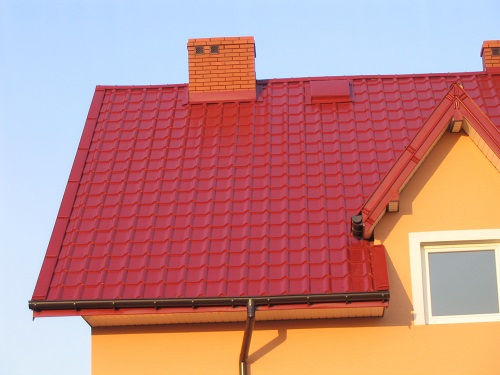
This type of roof is made on the basis of galvanized steel. Outwardly, it imitates shingles. Due to the fact that the material is treated with a special anti-corrosion compound, it can last for many years.
Many people, deciding which roof is better, choose metal tiles. After all, she:
- Easy to install;
- Differs in durability;
- It has a beautiful appearance.
Because the material is made of metal, it has exactly the same disadvantages as metal sheets.
Modern euro slate
This roof option is better known as Ondulin. It is made by pressing cardboard, and then impregnating it with a special bitumen impregnation.
Why, when builders choose how to cover the roof of a house, they often choose Euroslate? The answer is simple - this material will last over 30 years. In addition to everything, it has a low cost, and it is quite easy to install it.
The main disadvantage of Ondulin is the low strength of the material. And with rain or hail, all the noise easily gets inside the house.
How to cover the roof of the house? Mastic roof - the choice of millions
A polymer film that is already applied to the roof surface (reinforced concrete, wood, etc.) is called a mastic or self-leveling roof. A special composition is applied in a very thin layer to the surface, and when solidified, it turns into a monolithic coating.
People who are faced with the choice of which roof is better should pay attention to the advantages of the bulk material:
- Good waterproofing, because the roof is monolithic;
- High temperature resistance (the range of temperature that such a roof can withstand fluctuates in the range of -40 - +100 degrees);
- Resistant to UV rays;
- Light weight of the material.
Mastic roofing can be used to repair the roof of a house. Especially if only minor damage is observed.
Which roof is better? Maybe rolled?
Such material is bitumen, which is applied to a fabric or cardboard base. The most popular roofs of this type are roofing felt and roofing felt. Recently, people who are thinking about the question of what is the best way to cover the roof of a house are choosing glassine or glass-insulated.
All these types of roofs are frost-resistant, retain heat well, and are durable. And the method of their installation is very simple: a roll roof is laid on a flat roof surface in several layers, connected with liquid bitumen.
Often, to improve the mechanical properties of such a coating, it is covered with fine gravel or sand from above.
A good option is a soft roof

It is made from shingles. The base of the roof (polymer fabric or glass fabric) is covered with a self-adhesive layer. This allows you to simply glue the roof to the right place when installing the roof. Such styling is available to anyone, even a non-professional.
Soft roofs have a very wide range of shades. Among other things, they have high hydro, heat and noise insulation. And on top of that soft roof is very inexpensive.
Stacked roof - proven for centuries
Such material fits for a long time. After all, you have to collect the roof from small elements. The most popular option is shingles (ceramic or slate). This is one of the best options both aesthetically and durability. That is why someone does not even think about the best way to cover the roof, but they immediately choose a type-setting roof.
True, the tile has two significant disadvantages:
- To lay it, you need a strong frame that can hold it;
- This is the most expensive roofing option.
The choice of how to cover the roof of the house is always up to its owner. You need to evaluate your payment options and decide which qualities of the roof are more important for you: durability, ease of installation, aesthetic qualities, or something else.
When planning the construction or replacement of the roof of a house, we often take into account the cost as a decisive factor when choosing a covering. However, one should also consider the right choice material. In some cases, cheap material may ultimately become not so cheap due to expensive installation or maintenance. However, due to the wide offer of modern options on sale, we can choose optimal solution... The better to cover the roof of the house and the cheaper, and we will consider in this article.
The most popular are roofs made of shingles, roofing sheets or roofing felt. They differ in the method of installation, quality of materials and prices. However, some of the benefits of these materials can be key to your choice.
The cheaper to cover the roof of the house, the choice of the optimal solution
So, in conditions of a limited budget, we often face the question of how cheap to cover the roof of a private house? Among the most popular materials for roofing that are relatively inexpensive are:
- metal tiles or sheet metal (galvanized steel, copper);
- roofing felt (used in the case of flat roofs and surfaces with a slight slope);
- cement tiles;
- roofing bitumen of various shapes.
If we want to significantly reduce construction costs, we should abandon ceramic tiles in favor of steel. It is certainly not as durable and does not have the very good acoustic insulation and breathability of ceramic. However, it is the perfect choice for those who do not want to spend all their savings on roofing. Despite its many disadvantages, it also has many advantages, and we will pay attention to them first.

The advantages of steel roof tiles:
- the main advantage of the roofing sheet is its price, this applies to both the cost of materials and performance, including the rafter structure;
- steel shingle roofing is lightweight, which means that it does not require a roof structure as strong as for ceramics;
- the slope of the roof, which is required for the installation of the roofing sheet, must be higher than 9 ° -12 °, while there is also the possibility of installing the metal tile at a lower angle, but this requires a rigid roof sheathing;
- when installing simple and large roof surfaces, a small amount of waste is left, however, in the case of complex roofs this advantage is lost.
It is important to choose the right company that will install the roofing sheet. Incorrect cutting of sheet metal can cause damage protective layerslocated on the tiles.
The underlayment required under the roof must be the same as for ceramic tiles. In the same way, you will need strips, armor. They are fixed with a spacing that is adapted to the length of one module. The spacing is determined individually, as a rule, by the manufacturer. Some of them offer self-supporting shingles that have built-in load-bearing battens. Such a coating does not require the installation of a roof batten. When renovating a roof, lightweight metal shingles can be installed over the existing roofing sheet.
Another advantage of metal tiles is that they do not change their shape and weight when exposed to moisture. One square meter shingles weigh from 2 to 6 kg. This is almost ten times less than the weight of ceramic tiles.
However, due to the change in its size under the influence of temperature, it should be borne in mind that the most important thing in this type of roof is correct installation... The service life of this coating depends primarily on the quality of the sheet metal cut, the way of laying, etc. The warranty provided for this type of material is about 10-12 years.
One of the advantages of shingles sheet metal is its aesthetic appearance. Available on the market are leaf variants that have been treated with the appropriate fungicides and resins. They prevent the formation of algae and moss on the entire surface. This provides a better and more aesthetic appearance to the roof.
In the case of metal tiles, corrosion resistance, coating durability and color are very important. For this, it is often made of galvanized sheet steel and protected special coating made of polymer material. In some cases, the second side is also colored. Please note that this material requires proper cleaning and maintenance. From time to time, you will need to do repairs or paint with a primer.
Another problematic aspect of the operation of this type of coverage is snow. Unfortunately, excess snow can deform the surface.
Euroruberoid is one of the most popular materials that can be used for cheap roofing.
Its advantages:
- a light weight;
- relatively low price;
- performs well in all weather conditions;
- easy to lay;
- a well-laid euroruberoid retains its waterproof qualities for more than 30 years.

Different types of roofing material are laid in different ways, while some can be attached to glue, others can be liquid or require thermal styling. It is important that the coating is completely sealed.
![]()
Before laying the roofing material, the base should be primed, even if it is an old roofing material. This can be done using a special primer asphalt compound. Old roofing felt is a good base for a new one, keep this in mind because getting rid of the old layer is an expensive and very troublesome undertaking.
Roofing material should be laid at temperatures above + 50 ° С, while it is necessary to choose a day without precipitation. It should be noted that a wet surface, ice and strong wind can have a negative effect on its installation. Although it is slowly falling out of fashion, it has many advocates as the best option for those looking for a cheap and quick roofing solution. A roofing material roof is relatively inexpensive and durable.
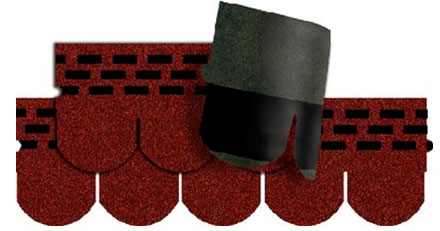 Bituminous shingles are another inexpensive option for those looking for a roof covering. The cost of this option depends on the shape of the bituminous tile, the layers of which it consists, as well as the quality of the primer.
Bituminous shingles are another inexpensive option for those looking for a roof covering. The cost of this option depends on the shape of the bituminous tile, the layers of which it consists, as well as the quality of the primer.
This solution is a popular alternative to ceramic roofing and sheet metal roofing. Bituminous shingles consist of several layers of fiberglass, bitumen, mineral or ceramic granules, sometimes with copper.
A shingle roof has a number of advantages, among which the following are most often paid attention to:
- relatively low price;
- ease of installation;
- versatility;
- it is light and thin - no more than 5 mm thick;
- easy to transport;
- resistant to damage;
- lightweight construction makes it suitable for roofs with almost any angle (except for flat roofs);
- bituminous shingles flexible, therefore it can be used on complex roofs, suitable for finishing complex architectural roofs, such as parapets.
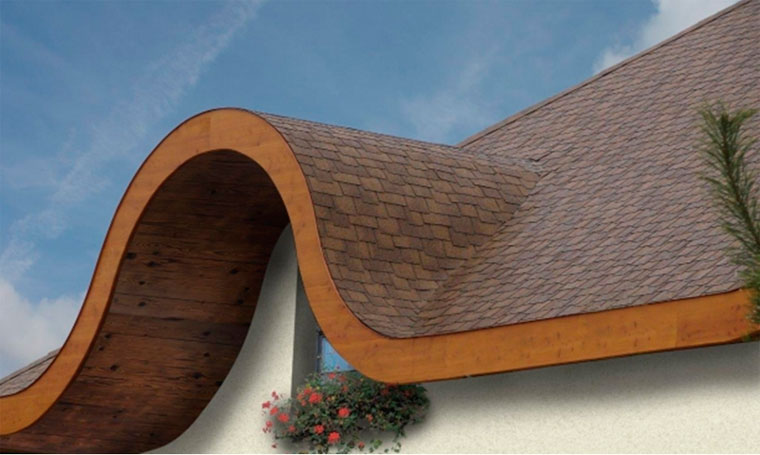
It is important to note that the roof covered with bituminous tiles can be easily restored, easy to install roof windows in already covered roofs. Noteworthy is the fact that shingles are quiet and do not reflect rain drops even during heavy showers, which is especially important in the case of covering houses with an attic.
Colored dusting on the bituminous coating gives it decorative view... The material comes in many colors, although the most popular are red, brown or grey colour... There are also shaded tiles that give the impression of being much thicker than they actually are, imitating ceramic coating or concrete.
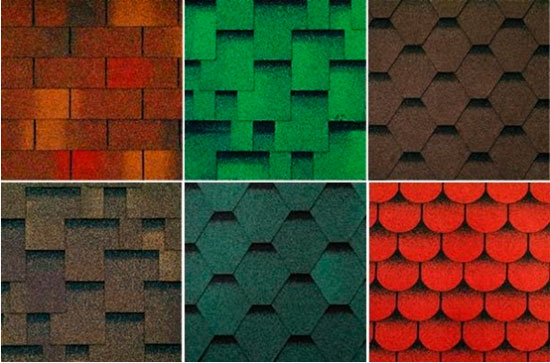
In the case of single-color options, you should not take elements from different batches when laying, since individual tiles may differ in shade.
Bituminous shingles can be of different shapes, which is important both for the aesthetics of the roof and in terms of cost. The cheapest hexagonal tiles due to the fact that they are cut without waste. Cutting tiles into the popular “fish scale” shape already generates more waste, so they are more expensive.
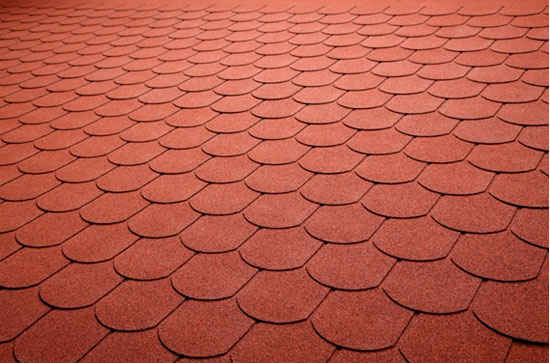
The classic tile shapes emphasize the traditional character of the building.
Installation. A characteristic feature of bitumen is that, under the influence of the sun, the elements are glued together on their own, therefore, each successive rows of tiles are glued and it is impossible for snow, rain and wind to get under them. Due to such self-vulcanization of the bituminous roof covering, installation work should be carried out under favorable weather conditions, best of all in the warm season from May to September. This process can be accelerated by reheating, for example with a burner.



